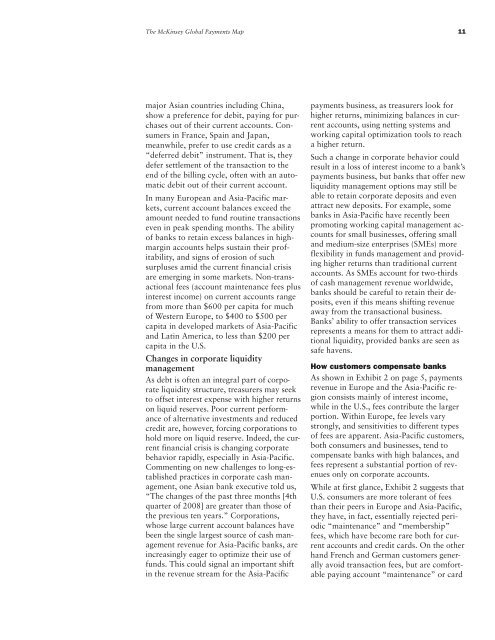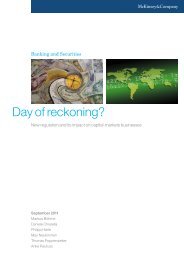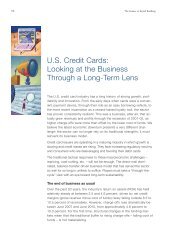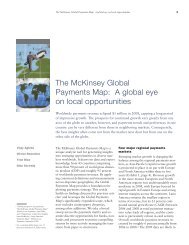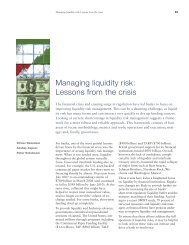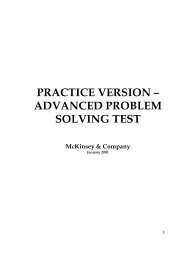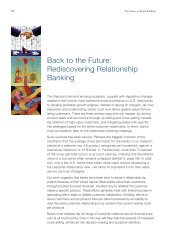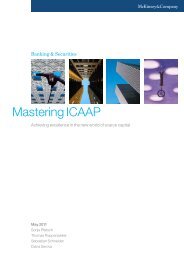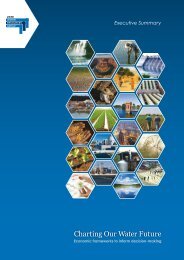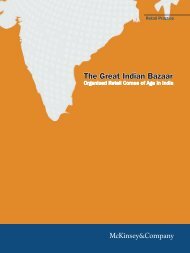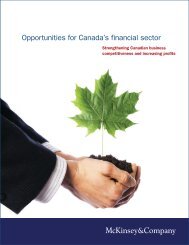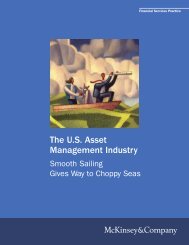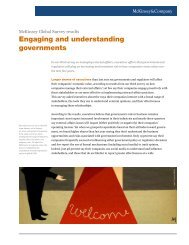McKinsey on Payments - McKinsey & Company
McKinsey on Payments - McKinsey & Company
McKinsey on Payments - McKinsey & Company
Create successful ePaper yourself
Turn your PDF publications into a flip-book with our unique Google optimized e-Paper software.
The <str<strong>on</strong>g>McKinsey</str<strong>on</strong>g> Global <strong>Payments</strong> Map11major Asian countries including China,show a preference for debit, paying for purchasesout of their current accounts. C<strong>on</strong>sumersin France, Spain and Japan,meanwhile, prefer to use credit cards as a“deferred debit” instrument. That is, theydefer settlement of the transacti<strong>on</strong> to theend of the billing cycle, often with an automaticdebit out of their current account.In many European and Asia-Pacific markets,current account balances exceed theamount needed to fund routine transacti<strong>on</strong>seven in peak spending m<strong>on</strong>ths. The abilityof banks to retain excess balances in highmarginaccounts helps sustain their profitability,and signs of erosi<strong>on</strong> of suchsurpluses amid the current financial crisisare emerging in some markets. N<strong>on</strong>-transacti<strong>on</strong>alfees (account maintenance fees plusinterest income) <strong>on</strong> current accounts rangefrom more than $600 per capita for muchof Western Europe, to $400 to $500 percapita in developed markets of Asia-Pacificand Latin America, to less than $200 percapita in the U.S.Changes in corporate liquiditymanagementAs debt is often an integral part of corporateliquidity structure, treasurers may seekto offset interest expense with higher returns<strong>on</strong> liquid reserves. Poor current performanceof alternative investments and reducedcredit are, however, forcing corporati<strong>on</strong>s tohold more <strong>on</strong> liquid reserve. Indeed, the currentfinancial crisis is changing corporatebehavior rapidly, especially in Asia-Pacific.Commenting <strong>on</strong> new challenges to l<strong>on</strong>g-establishedpractices in corporate cash management,<strong>on</strong>e Asian bank executive told us,“The changes of the past three m<strong>on</strong>ths [4thquarter of 2008] are greater than those ofthe previous ten years.” Corporati<strong>on</strong>s,whose large current account balances havebeen the single largest source of cash managementrevenue for Asia-Pacific banks, areincreasingly eager to optimize their use offunds. This could signal an important shiftin the revenue stream for the Asia-Pacificpayments business, as treasurers look forhigher returns, minimizing balances in currentaccounts, using netting systems andworking capital optimizati<strong>on</strong> tools to reacha higher return.Such a change in corporate behavior couldresult in a loss of interest income to a bank’spayments business, but banks that offer newliquidity management opti<strong>on</strong>s may still beable to retain corporate deposits and evenattract new deposits. For example, somebanks in Asia-Pacific have recently beenpromoting working capital management accountsfor small businesses, offering smalland medium-size enterprises (SMEs) moreflexibility in funds management and providinghigher returns than traditi<strong>on</strong>al currentaccounts. As SMEs account for two-thirdsof cash management revenue worldwide,banks should be careful to retain their deposits,even if this means shifting revenueaway from the transacti<strong>on</strong>al business.Banks’ ability to offer transacti<strong>on</strong> servicesrepresents a means for them to attract additi<strong>on</strong>alliquidity, provided banks are seen assafe havens.How customers compensate banksAs shown in Exhibit 2 <strong>on</strong> page 5, paymentsrevenue in Europe and the Asia-Pacific regi<strong>on</strong>c<strong>on</strong>sists mainly of interest income,while in the U.S., fees c<strong>on</strong>tribute the largerporti<strong>on</strong>. Within Europe, fee levels varystr<strong>on</strong>gly, and sensitivities to different typesof fees are apparent. Asia-Pacific customers,both c<strong>on</strong>sumers and businesses, tend tocompensate banks with high balances, andfees represent a substantial porti<strong>on</strong> of revenues<strong>on</strong>ly <strong>on</strong> corporate accounts.While at first glance, Exhibit 2 suggests thatU.S. c<strong>on</strong>sumers are more tolerant of feesthan their peers in Europe and Asia-Pacific,they have, in fact, essentially rejected periodic“maintenance” and “membership”fees, which have become rare both for currentaccounts and credit cards. On the otherhand French and German customers generallyavoid transacti<strong>on</strong> fees, but are comfortablepaying account “maintenance” or card


